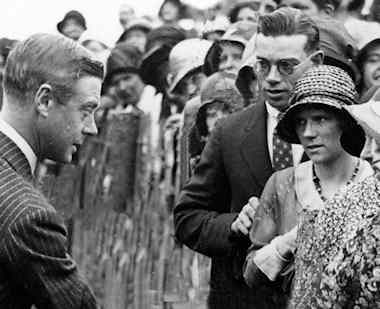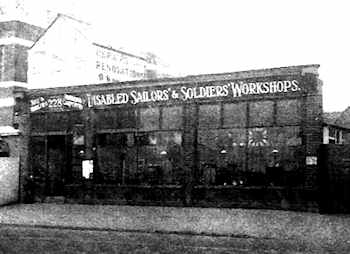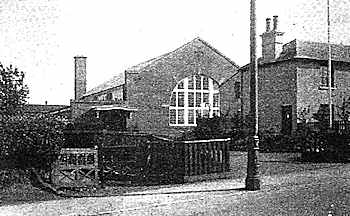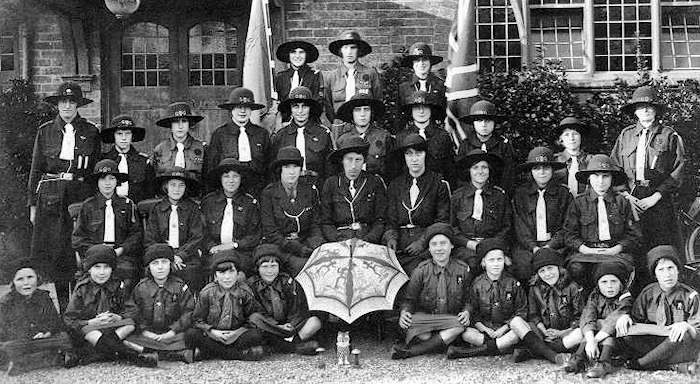|
Winton's Royal Visit
Winton has had just one official royal visit. It
was on 19 October 1927 and the visitor was Edward, the Prince
of Wales.
 Nine
years later he plunged the nation into an abdication crisis after
becoming king and then insisting on marrying his American divorcee
lover, Mrs Simpson. Nine
years later he plunged the nation into an abdication crisis after
becoming king and then insisting on marrying his American divorcee
lover, Mrs Simpson.
In 1927, though, he was visiting every part of
the country as part of a "see and be seen" campaign.
The previous year Britain had been in the grips
of its first General Strike - an event that had struck fear into
the hearts of the Royal Family in particular.
They saw it as the possible prelude to a Bolshevik-style
revolution that could end with them sharing the fate of the Russian
Tsar and his family. The execution of the Russian Royals was still
relatively recent - just nine years before.
The roots of many of the problems afflicting Britain
and the rest of the Western World lay in the terrible losses of
the First World War. Most men who survived returned home scarred
in one way or another - and there was a questioning discontent
about whether it had all been worth it.
Not surprising then, that when the Prince of Wales
visited Winton his first stop was a special workshop set up to
employ disabled servicemen.
 The
Disabled Soldiers and Sailors Workshop was built on Peter's Hill
next to a plot that was to be the site of the Fire Station. It
was run by a formidable lady known as Miss H A Smith. The
Disabled Soldiers and Sailors Workshop was built on Peter's Hill
next to a plot that was to be the site of the Fire Station. It
was run by a formidable lady known as Miss H A Smith.
She had started her work for disabled servicemen
in 1915 when she began to raise funds from a kiosk on Bournemouth
Pier selling woollen garments, soft toys, hand-painted calendars,
basket work and needlework. Gradually she gathered a small army
of helpers, including Major General Sir Harry Brooking who was
to become chairman of the charity.
When it started operation in 1922, the workshop
employed eighteen men. The pay was small and they could not compete
with able-bodied men. But they retained their pride, self respect
and hope for the future. They produced leather work, basket work
and toys.
The Prince of Wales's car arrived at the Workshop
just before three o'clock in the afternoon. He talked to the men
and looked at their work. After brief conversations with Miss
Smith and Major General Brooking he was off again, waving to assembled
onlookers and making his way to the British Legion Hall a hundred
yards down the road where he met more war veterans. Next stop
was Jameson Road where the new YMCA building was due to open in
a few months time..
For years afterwards a local resident used to tell
the story of how a crowd of mothers with young children were standing
on the corner of Jameson and Wimborne Roads. As the party made
its way down Wimborne Road, the Prince apparently looked thoroughly
fed up. He was surrounded by civic officials and aides, but when
he saw the children on the corner he broke away from the official
party, came across and bent down to talk to the children, his
face warm and smiling. After several minutes one of the officials
came and said something to him (possibly reminding him opf his
timetable). He looked annoyed, stood up and walked on up Jameson
Road.
In spite of his playboy lifestyle and later abdication, a mother
who witnessed it all said she felt she had seen the human side
of the man.

British Legion Hall, 1927 |
A short time later it was back in the car and off
via Edgehill Road, Frederica Road, Talbot Road, Talbot Avenue
and Wimborne Road to a Toc-H Ceremony of Light at St Augustine's
Church.
Toc-H was another charity with its origins in the
First Word War. Dedicated initially to giving hope, comfort and
respite to men in the trenches, its iconic lamp symbolises a spirit
of unselfishness and service to others.
The Bournemouth branch had been established in 1925
when it received its symbolic Lamp at a ceremony in London from
none other than the Prince of Wales.
After the Toc-H ceremony at St Augustines the Prince
made a brief visit to Poole and was back on the 5 o'clock train
for London.
It had been a busy day. Before he even arrived in
Winton the Prince had inspected five different guards of honour
and viewed five different buildings and then listened to eight
thousand schoolchildren, Scouts, Guides and Boys' Brigades sing
'Land of Hope and Glory' at a rally in Meyrick Park .
But all that was nothing compared to the fuss that
was coming in 1936!
The Moordown Guides and Brownies were almost certainly
present at the rally which the Prince reviewed. Here is a picture
of them taken in the mid-1920's.

The Royal visit was of course timed and organised
down to the last minute. Less so were the odd occasions when VIPs
happened to pass through Winton on their way to somewhere else.
Possibly the most notable of these fleeting appearances was in
1909 when King Edward VII's motorised entourage swept through
cheering Winton crowds on its way from Bournemouth Railway station
to Milton Abbas where the king was to spend a couple of days pheasant
shooting. A photographer managed to capture the procession.

|